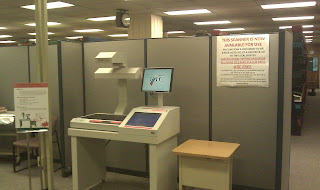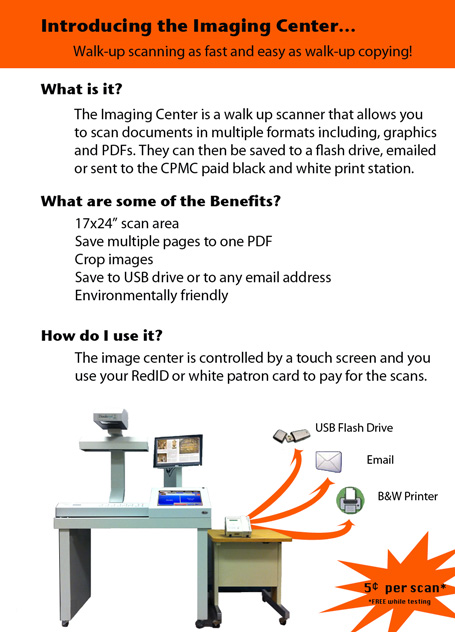The Library has replaced the +25 year old green screen Public PAC Wyse Terminals with re-purposed Gateway computers. In short, the reason for the switch - the text-based search used by the terminals is not supported in the next release of the PAC software and maintaining the aged serial device network, PACNET is a pain.
Patrons can now enjoy familiar web-based searching and Library IT staff have much easier methods of managing the hardware/software.
 |
(looks vaguely familiar. Is this Gopher?) |
What happened to the PAC Plus (WYSE) terminals?
You may have noticed that the old “PAC Plus” green screen terminals with their ancient, text-menus have been replaced throughout the library with new PC workstations displaying a simplified version of WebPAC (hmm, looks familiar, but something is missing…).
This was the
culmination of a number of factors:

- III announced last summer that they would no longer support text-based public interfaces in their next major release (expected this summer) so the clock began tick, tick, tocking.
- The technology supporting the WYSE terminals and connecting them to PAC (via PACnet) was circa early 90’s (and had the cobwebs to prove it!). [I know, doesn’t seem that long ago, but in the IT world this is like comparing a stylus and clay to a ball point pen and paper, or perhaps an IPAD]
- Students are genuinely stymied when presented with a simple text menu with 4, single-letter commands (um, looks hard. Where’s the mouse?).
- We were still paying a little over $200/yr in maintenance for a customizable, public, text-menu (“PAC Plus”) although the software hadn’t been improved since the ‘90s. In fact, the text-interface had gradually lost functionality over the past several releases. INN-Reach Pass-thru searching (to LINK+ & Circuit) was lost after a change in access protocol in Release 2008 and patron holds could no longer be placed in Release 2009.
So, the writing was on the wall, and while it would have been simpler to just re-use the PC image deployed on the public Reference workstations, point them at Infodome and leave it at that, there was still a need to provide a means to look up call numbers (for books) in the book stacks where most of this kind of activity often occurs.
 |
Firefox was also essentially placed in a straightjacket and
a number of features ‘external’ to WebPAC such as ILL,
Infoguides, the Periodical Title search , etc. were suppressed
using some added coding and a local stylesheet. |
Luckily, we were able to draw on the IDT brain pool
(for a tasty punch - add 2 Brians, 1 Dennis, 1 Keven, 1 Kyle & 1 Steve – stir liberally with 1 Mark) in coming up with a simple, manageable (mostly pain-free) solution which was quickly deployed (really quickly – like 2 months.
We had a working prototype in November and the final version by December) by Juan and Steve Voelker.
So, how did we do it? (or why? – see above)
In order to thwart patrons basically camping out on these PCs perusing e-resources (or CNN) while others desperately foraged in the stacks, WebPAC was selected as the starting point instead of Infodome.
So far it seems to be working pretty well.
Benefits:

Patrons aren’t finding their way out away from the catalog to aimlessly wander the World Wide Interwebs and Inhouse
PAC searches are up 260% Jan-Apr 2011 compared to last year.
Ironically, the PCs will soon be replaced with a new type of ThinClient, that will provide a full Windows browser experience but allow for easier centralized management and configuration... we've come full circle!
 PachyDerm is a browser based authoring platform designed for people with little multimedia experience. The tool is accessed through a web browser and is as easy to use as filling out a web form. Authors upload their own media (images, audio clips, and short video segments) and place them into pre-designed templates, which can play video and audio, link to other templates, zoom in on images, and more.
PachyDerm is a browser based authoring platform designed for people with little multimedia experience. The tool is accessed through a web browser and is as easy to use as filling out a web form. Authors upload their own media (images, audio clips, and short video segments) and place them into pre-designed templates, which can play video and audio, link to other templates, zoom in on images, and more. SCUA is using it to develop presentations using pre-determined templates for their collections. Their patrons then can access these presentation via links on SCUA’s website. PachyDerm has already been used to author Online Exhibits such as:
SCUA is using it to develop presentations using pre-determined templates for their collections. Their patrons then can access these presentation via links on SCUA’s website. PachyDerm has already been used to author Online Exhibits such as: 




